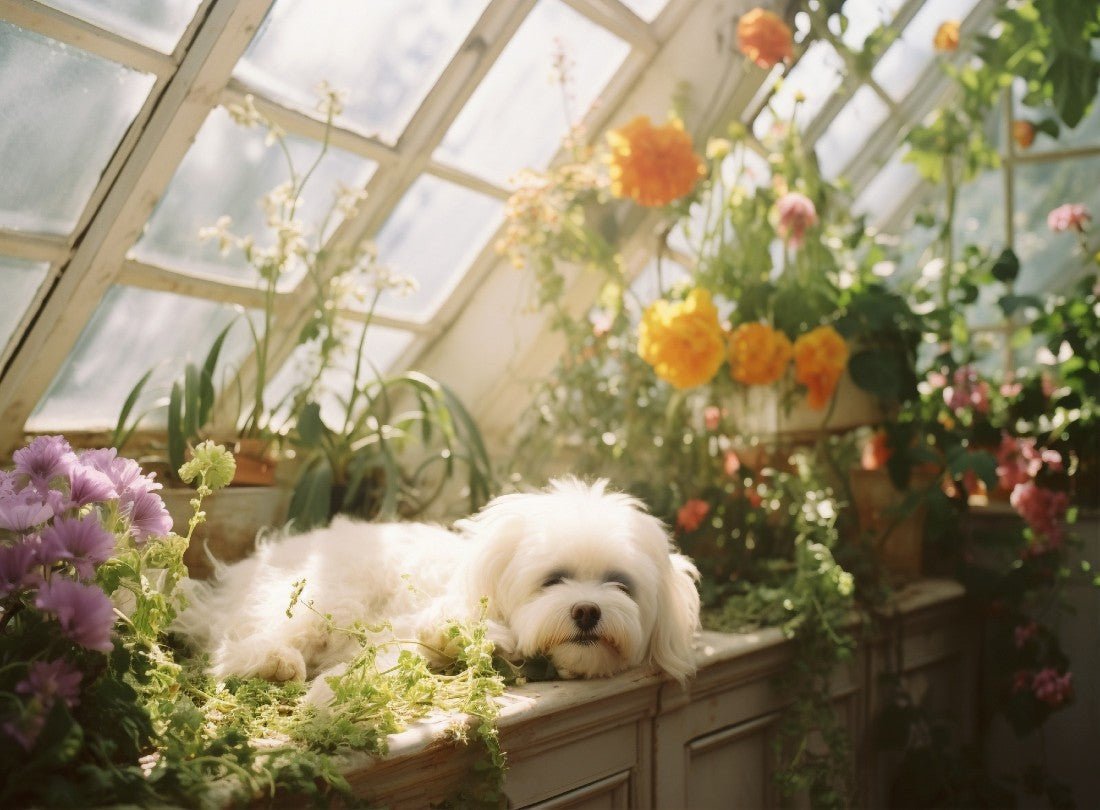“Murdered” plants are not what you wanted to see after a hard day at work.
But alas, it’s exactly what’s strewn across the floor - your new faux plant. And it was a costly one, too.
And standing amidst the aftermath of a wrestling match is your furry friend. A sheepish expression etched on their face as if saying, “Oh, you’re home early!”
After the initial shock, a new concern fills your mind. What exactly did your four-legged menace ingest while creating this masterpiece?
Are fake plants safe for pets? Should you be rushing to the vet straight away?
Let’s talk about it.
Are Artificial Plants Safe for Pets?

Generally, yes.
But let’s reel it back a bit and comb through the details.
As the responsible pet parent that you are, you’d be loath to decorate with anything that can inflict pain on your furry pal. So what’s the deal?
Let out a sigh of relief because your new artificial vertical garden is non-toxic and unlikely to cause harm if ingested. Usually, it will go right through your pet.
So, you won’t have to track your inquisitive puppy or kitten like an army helicopter when they’re playing near your new fake plants.
But as much as we want this to be the end of the discussion, we must draw attention to a few important factors. Since our artificial greenery contains low-density polyethylene (LDPE), a type of plastic, it can be a choking hazard.
Like other miscellaneous items around your home, if your pet chews or tears apart your fauxliege, it could lead to an obstruction in their airways or digestive system.
So in short: while ingesting materials and dyes likely won’t cause harm, choking hazards are still present. As a result, inspect your fauxliege regularly for any sign of damage to ensure your pet’s safety.
Are Real Plants Safe for Pets?
Some are. Some aren’t.
Unfortunately, the risk is greater with real plants. While certain plants won’t cause a ruckus in your pet’s belly, others can be toxic (and even fatal) if ingested.
Research a plant’s toxicity level and opt for plants you’re certain are non-toxic for dogs, cats, and other animals you own. For example, some of the best pet-safe plants on the market include:
- Rattlesnake Plant
- Spider Plant
- Venus Flytrap
- Boston Fern
- Orchid
- Bromeliad
But keep in mind that although these plants aren’t poisonous, you should still make sure your pet doesn’t eat them. They’re decorations, after all.
Which Plants Are Dangerous to Pets?
Unfortunately, there are a myriad of toxic plants out there, many of which are popular among plant parents, such as:
- Lily
- Aloe
- Marijuana
- Azelea
- Castor Bean
- Gladiola
- Cyclamen
- English Ivy
- Pothos
- Asparagus Fern
- Begonia
- Daisy
- Holly
- Dahlia
- Devil’s Ivy
- Eucalyptus
- Fiddle-Leaf
- Geranium
- Hyacinth
- Milkweed
This might be a long list already, but it doesn’t paint the full picture. For more information, refer to the comprehensive lists of plants toxic to dogs and cats from the ASPCA. And before you buy a new plant, consult the list and your veterinarian to ensure your pet’s safety.
If you’ve noticed your pet nibbling on any forbidden fruit, watch out for signs of poisoning. Common symptoms include:
- Vomiting
- Diarrhea
- Drooling
- Lethargy
- Seizures
- Twitching
Should these appear, head to the vet clinic immediately.
How to Protect Your Pets and Plants?

Balancing your pet’s well-being with your admiration for greenery requires just a few, easy-to-do tweaks. You should:
Keep Plants Out of Reach
Yes, your faux plants are beautiful.
But they won’t be for long if you keep them in your pet’s favorite area. If you don’t want a crime scene on your hands and the lovely duty of sweeping soil off the floor, keep your plants away from your pets.
You can do this in many ways, including:
- Establishing designated play areas equipped with toys, bedding, and your pet’s faves
- Using artificial hanging plants or wall-mounted shelving with plant displays
- Designating separate rooms as off-limits to your pets
All in all, creating physical barriers will minimize the risk of unwanted interactions and divert your pet’s attention. If you keep your foliage out of the way and have beloved toys in the room, they won’t look at your plants twice.
Pet-Proof Your Plants
A dog’s sense of smell is 40 times more sensitive than a human’s. Use that to your advantage.
Cordon off your plant area by drenching it in scents your pet dislikes. If you don’t know what those are, try citrusy scents first. While your pets need a healthy dose of Vitamin C in their diet, most of them can’t bear the smell of it. Luckily, we humans don’t have that aversion.
Create your own pet repellent by diluting lemon juice and spraying your faux plants. Spray the fauxliege regularly until your pet completely loses interest in playing with it. Just don’t spray from up close to avoid staining the leaves.
And if your pet has made your new potted fake plant into an excavation site, put some lemon or orange peels around the stems and let them work their magic.
Train and Exercise Your Pets
Is a tired dog really a good dog?
In many situations, that rings true. When pets act destructively, it often indicates a lack of exercise. If your pet has leftover energy to chew on, bat at, and dig around your plants, pick apart their daily routine.
Your dog should get daily exercise to get their little heart pumping. Cats, on the other hand, love an intense play session with feathers or tassel toys. When they don’t get that, they try to find it elsewhere and wreak havoc on your fauxliege.
But besides exercising, train your pets and use positive reinforcement to encourage them to stay away from your plants. This means giving them treats and cuddles when they’re keeping their distance and teaching them commands like “leave it”. With repetition, they’re bound to learn eventually.
Replace All Toxic Plants
If you have any real poisonous plants in your home, give them away immediately. Thorough research is your friend. After uncovering which plants pose a risk, replace them with faux alternatives.
For example, if you have real boxwood at home, it can threaten your pet’s health. But if you replace it with a realistic artificial boxwood wall, that threat will be no more. Plus, you won’t have to sacrifice your carefully-curated aesthetic.
And if you have stunning (but highly toxic) ivy in your yard, you can maintain the same look and feel with a fake Boston Ivy green wall. All in all, you don’t have to change everything in your house to accommodate your pet, you just need to make a few simple adjustments.
Finishing Thoughts
If you include these tricks in your arsenal, the anxious thoughts before bed will give way to peace and assurance.
After learning that fake plants are safe for pets, you can focus on creating a space where pets and greenery can thrive together. Then, all those unnecessary trips to the vet will become a memory of a distant past.
FAQ
Most high-quality fake plants are safe for pets and won’t poison them. The only thing you need to worry about is pieces of plastic getting stuck in their airways. So, if your pet has chewed up some artificial greenery, keep an eye on them for a while to ensure they don’t choke.
Well-made, high-quality artificial plants are entirely safe for cats and not toxic. However, make sure your cat doesn’t choke on tiny bits of plastic.
Reptiles may try to eat any colorful fake plants. Although they probably won’t like the taste, they may be determined to take a bite. This could lead to indigestion or bowel obstructions, which can harm your reptile. As a result, it’s better to keep them away from fake plants.
Some non-toxic plants for pets include: Bromeliads, Orchids, Venus Flytraps, Boston Ferns, Spider Plants, Rattlesnake Plants, Christmas Cacti, African Violets, etc.


